It’s been a while since I finished writing Chess Structures, but I like the topic so much that I keep coming back to it – I know how much it improved my understanding of chess. I follow games on Chessbomb pretty much daily and I really enjoy it when I see a nice ‘structure-concept’ being applied. Often these games reproduce ideas shown in the book almost identically, while sometimes there are small (yet very important!) differences. So I thought, why not start a blog in which I will, once in a while, post a game which builds upon the ideas I shared with the readers of my book. Since the hardest point of starting a blog is finding any readers at all, John offered his help, suggesting I post a couple of guest blogs here. The permanent location of my blog will be chess-structures.com, though it will take me about 4-5 days to set it up properly, since I am a complete beginner as far as websites go.
Now let’s get started with some chess. As you may have realized, almost every game in my book was decisive (that is, not a draw) since drawn games (especially agreed draws) are like an unfinished story, and people just don’t like to read stories without an ending… Anyway, the only exception to this rule was Onischuk – Dominguez from the World Cup of 2013. This game was a Carlsbad structure (Chapter 5) which I thought was very instructive, as it shows how Black might completely neutralize White’s queenside plans. A few days ago, as I was following the Women’s World Championship in Sochi, I found a great example which pretty much takes off where Dominguez left off, and brings home the full point. The contenders: young star Guo Qi from China was White against World finalist Natalia Pogonina. Let’s see the game:
1.d4 Nf6 2.Nf3 d5 3.c4 e6 4.Nc3 Be7 5.cxd5 exd5 6.Bg5 c6 7.Qc2 Nbd7 8.e3 Nh5 9.Bxe7 Qxe7 10.Be2 Nhf6
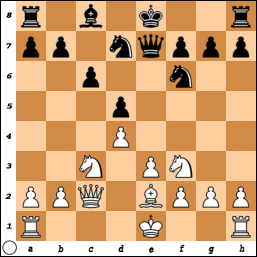
11.Nd2?!
White deviates from theory, possibly to prevent …Ne4. This is a little imprecise since quickly playing b2-b4-b5 should be the priority.
Normal was 11.0–0 to follow up with Rab1, b2-b4-b5, and if 11…Ne4 12.Nxe4 dxe4 13.Nd2 Nf6 14.Rab1!? we have transposed to Chapter 20, the French Type II (with colours reversed) where White’s prospects are good, since the break b4-b5 is easy to carry out, and Black lacks material (and moves) to create serious kingside threats.
11…Nb6 12.0–0 0–0 13.Bd3
If 13.Rab1 then 13…Bg4! 14.Bd3 Bh5 is similar to the game.
13…Bg4 14.Rab1 Bh5!
Black is aiming to trade light-squared bishops, which is a good idea.
15.b4 a6
A standard reply, to trade off a-pawns, getting rid of a potential weakness.
If 15…Bg6 then 16.Bxg6 hxg6 17.b5!? would typically create problems for Black, since both the a7- and c6-pawns can become weaknesses, however White’s play has been imprecise, and after 17…Rfc8 18.bxc6 Rxc6! Black has good counterplay (but not 18…bxc6? when White is a little better).
16.Na4
After 16.a4 Bg6 17.Bxg6 hxg6 the standard 18.b5?! is met strongly by 18…cxb5 19.axb5 a5! with an edge. Black has a passed pawn, making White’s entire enterprise a failure.
16…Nxa4 17.Qxa4 Bg6 18.Bxg6 hxg6 19.Qc2
My favourite moment in the game; Pogonina is doing well, but now how should she stop a4 and b4-b5?
19…Ne8! 20.a4 Nd6
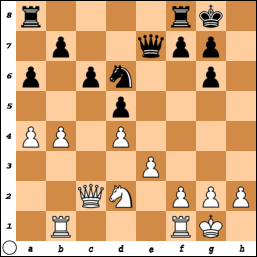
Black is slightly better.
The position is almost identical to the game Onischuk – Dominguez (annotated in Chapter 5). White’s queenside play is no longer dangerous. The big difference between this game and the one in the book is that here Black has a half-open h-file, creating better prospects for kingside play.
21.Rfc1
White continues a futile attempt at queenside play. If instead 21.Rfe1, trying to simplify with e3-e4, then 21…Rfe8! and White is unable to escape from her inferior position.
21…Rfe8 22.Qd3 Rac8 23.Nb3 g5!
Black begins the kingside action!
24.Nc5 g6 25.Re1 g4
Black has an easy plan: …Kg7, …Rh8, …Qh4 and a checkmating attack. Meanwhile, has White made any progress on the queenside?
26.Qe2 Qh4
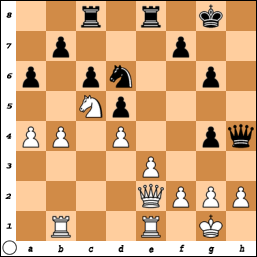
27.f4?!
White neutralizes the kingside attack, at the cost of a permanent weakness on e4. More solid was 27.g3 Qg5 28.f3 gxf3 29.Qxf3 Kg7 when Black has just an edge.
27…Kg7 28.g3 Qh3 29.Qg2 Qh5 30.Rb2
30.e4? would not help after 30…dxe4 31.Nxe4 Qd5! 32.Nxd6 Qxd4+ 33.Kh1 Qxd6–+.
30…Re7 31.Qf1 Nc4 32.Rbe2 Rce8 33.Qf2 a5!
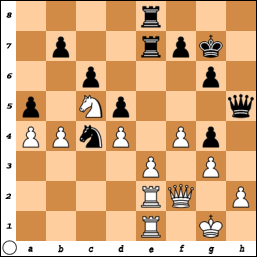
Black is clearly better. White’s forces are tied down, and Black creates a second front of attack. As it turned out, only Black was able to create threats on the queenside. The rest of the game bears less relevance to my topic, so I will leave it almost no comments.
34.bxa5 Qf5 35.Nb3 Qd3 36.Nc5 Qf5 37.Nb3 Kf8 38.Nc5 Nxa5 39.Rb2 Kg7 40.Rb4 Kg8 41.Re2 Qc8 42.Nd3 f6 43.Nb2 Qc7 44.Qe1 b6 45.Qc3 Kg7 46.Kf2 Nb7 47.Nd1 Nd6
All of Black’s dreams have come true and another diagram is in order!
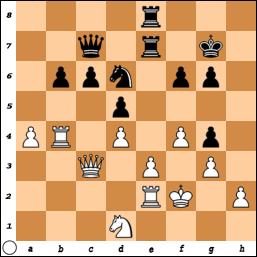
48.Qd3 c5 49.dxc5 bxc5 50.Rbb2 Ne4+
50…c4!–+
51.Kg1 Qc6 52.a5 d4 53.Rb6 Qd5 54.a6 Rd7 55.Reb2 Nd6 56.Rf2 Nf5! 57.Re2
Or 57.exd4 Re1+ 58.Rf1 c4! 59.Qd2 Rxf1+ 60.Kxf1 Qh1+ forces checkmate.
57…c4–+
Black’s central pawns begin to roll, deciding the game nicely.
58.Qb1 d3 59.Ra2 Nxe3 60.Nc3 Qd4 61.Rb7 Nd5+ 62.Kf1 Nxc3
White resigns.
I don’t know about you, but finding this game made me really happy!
Final Remarks
1. A tiny structural difference (the capture …hxg6) gave Black good kingside prospects at absolutely no risk.
2.To nobody’s surprise, placing a knight on d6 to stop White’s queenside play proved effective once again.
I shall return in about a week with another example of “Chess Structures in practice”.
I like your book and I like such examples. Thanks!
Great article and I love your book as well! Thanks for sharing this with the readers on this blog!
Great book and great post.
If you were able to do what chessbase does and embed the commentary into a playable board (like the board you put at the end, but with the commentary in it) it would make it easier to follow by patzers like me.
BEST OF LUCK WITH THE NEW BLOG…THANKS FOR SHARING YOUR KNOWLEDGE…BEST
Awesome blog post. Thanks!
@MARIOZEVICH
@Seth
@Gollum
@Ray
@wolfsblut
Thanks for your comments, I really appreciate them. My blog continues to be under construction, just got a couple pieces of text so far… Anyway, I am open for suggestions, if there is something you look forward to on my posts, please share your opinion and I will try to include it once an example becomes available ( trying to prioritize the most current games )
Nice Mauricio!!
I ordered your book a few days ago and I’m anxious to check the references you make in this post.
A future follower of your blog 😉
I have to add that with the move order above black could have done much better: After 7….g6 she should be equal…..
PROVIDE A FOLLOW UP FOR THE CONCEPTS CONSIDERED IN A CHESS BOOK,COULD BE A NEW WAY FOR CHESS EDITORS TO OFFER A BETTER AND MORE COMPLETE PRODUCT,…TROUGH A WEB PAGE OR BLOG (SUBSCRITION REQUIRED)….MAY BE YOU ARE A PIONEER,MAURICIO¡¡¡…REGARDS
Sorry for the silly question, what’s the link of the blog? I can’t find it…
@garryk
I think Mauricio is still setting up his blog. He says in the post it will take him 4-5 days, and that was about 2 days ago. So the blog should exist soon.
It’s there now, so bookmark it
http://chess-structures.com/
I like the first installment. The only criticism I have about the book is it needed some more examples. It is a criticism I have seen in some reviews also. If the only valid widespread criticism of a book is that is too short you may have a winner!
Mauricio- I was wondering what you thought of Fischer’s comments on the Fischer-Spassky Benoni (1992) game in p243 of your book. “I should have sealed the queenside at some point with b4 probably, and I suppose he still has a slight edge”. (Post game press conference, transcript as per Seirawan’s No Regrets”.
You don’t consider sealing with b4 at all, and was wondering what you thought?
@Paul I agree that sealing the queenside with b5- b4 would have reduced Black’s problems, but it also would have reduced his counter play. White would have still had a big advantage because of the potential piece sacrifices on f5, as well as the plans h5-hxg6 followed by Nf3-Nh4 attacking g6. I think White would have won eventually, but you are probably right that closing the queenside could be useful.
@John Johnson @MARIOZEVICH Thanks for your comments, I agree that it would be nice to add more content, but you have to draw the line somewhere, and long books have other problems too, like the spine can break and so on. The idea of the blog is to provide some kind of complement, fill up some gaps, and also just have fun reviewing current games.
By the way, I just finished my second post, you can see it on chess-structures.com, it’s in both English and Spanish. I will do another post to post here at the QC blog later in the week, but for now I have this post which is a little different, as I analyze a game I played when I was 14…
Great blog too.
If I can give you some advice (apart from putting the commentaries into a game viewer so it is easier to follow), don’t double-post in english-spanish. Just put a language selector on the web so only the language you select is shown.
I understand both, and it is very odd to see the post duplicate, I cannot imagine how would someone that does not understand both feel.
Oh, and a question, which is the original language of the post? I rather read the original than the translation.
@Gollum Thanks for the tip, I wanted to do what you describe, but didn’t find a plugin to handle this, but I will find a way to handle this more smoothly. About the “original” post, I write in English first, then translate back to Spanish.
Really impressive stuff, great work. Best of luck with the blog, I’ll certainly be checking it out! 😉
@Mauricio Flores
Thanks for your thoughts! And I loved the book!
@Mauricio Flores
Es siempre una ventaja que escribas en los dos idiomas, para que los hispanohablantes puedan aprender más sobre la estructura de peones, además del ajedrez en general. Bien hecho con el libro y suerte con el blog. ¡Ánimo!
Estoy de acuerdo con ese comentario. También Google Translate es una herramienta increíble.
@Nick
Pero no hace falta que recurra a ningún traductor. Algunos de nosotros hablamos otros idiomas con fluidez, aunque parezca que no…
Fair play and I also agree Gilchrist WAS a legend!!
Fair enough, I’m sure I’ve seen you speak Dutch on this site too. Very impressive.
@Nick
Best keeper-batsman in my opinion. I have a feeling that if he played chess he would play the Najdorf and Botvinnik Semi-Slav.
I’d have said the Dragon
@ Gilchrist is a Legend
I also believe Gilchrist (Australia) best keeper-batsman I have seen with, in my opinion, Kumar Sangakara (Sri Lanka) probably second. Both very impressive.
If he played chess I think maybe he would play gambits that would suit his aggressive style of play (with the bat).